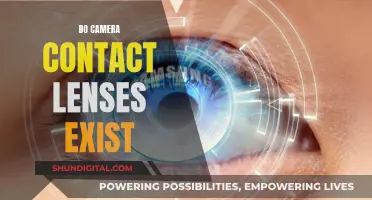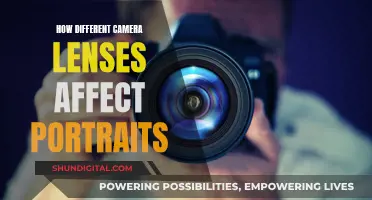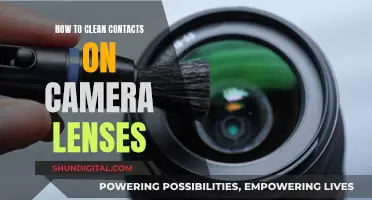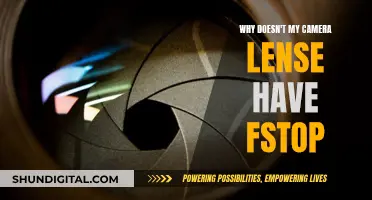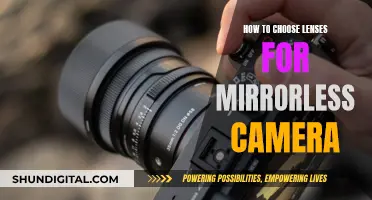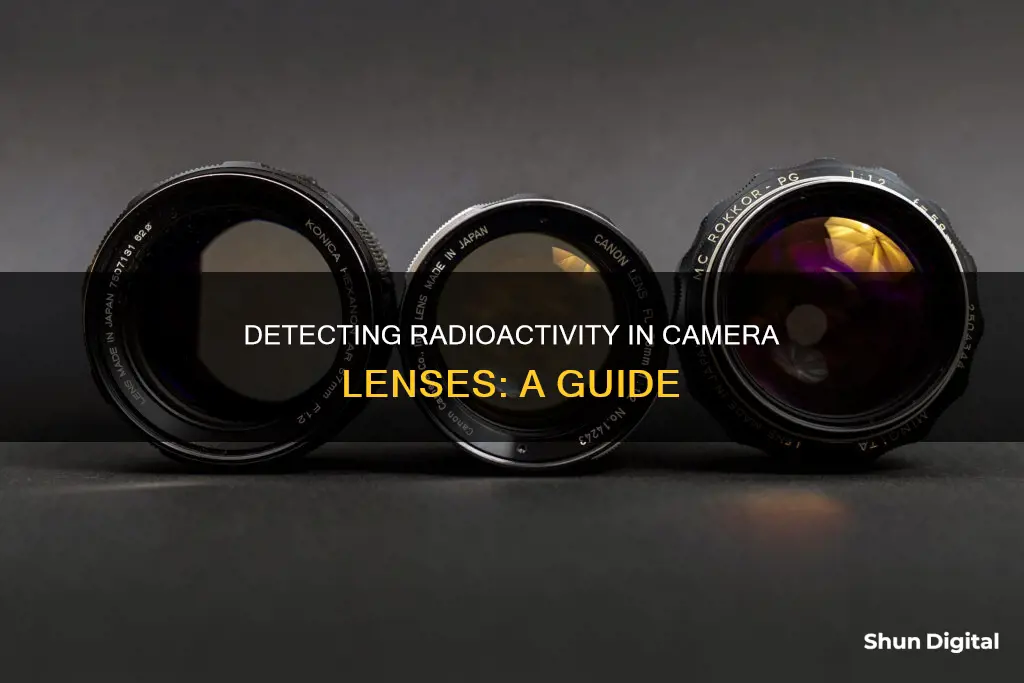
Many vintage camera lenses produced between the 1940s and the 1970s contain thorium, a radioactive element that improves image quality. However, thorium-containing lenses are not easy to identify, and there is a lot of misinformation about their potential health risks. While some sources claim that these lenses are entirely harmless, others warn of serious dangers such as cancer. The truth lies somewhere in between these extremes. While the radioactivity of these lenses is not strong enough to cause immediate health concerns, it is important to treat them with care and avoid breaking or grinding them, as this can release toxic elements and increase the risk of radiation exposure. To identify a radioactive lens, look for a yellowish tint on the glass, which indicates the presence of thorium. Alternatively, a Geiger counter can be used for a more accurate measurement.
What You'll Learn

Lenses with thorium oxide are radioactive
The addition of thorium oxide to the glass increases the refractive index, which means light travels slower within the glass and changes direction more easily. This allows lenses to have a lower profile, requiring less material and thus being lighter.
Thorium oxide has a crystalline structure similar to calcium fluoride (fluorite). Like fluorite, it has optical properties of high refractivity and low dispersion, allowing lens designers to minimise chromatic aberration and use lenses of lower curvature, which are less expensive to produce.
Lenses with thorium oxide were mainly produced from the 1940s to the 1970s. Eastman Kodak was the most prolific known producer of these lenses, and other manufacturers like Canon, Konica, and Asahi Pentax also used thorium in their lenses made between about 1945 and 1980. The use of thorium in lenses eventually fell out of use due to health concerns and consumer radiophobia following nuclear accidents.
The presence of thorium in the lens can cause moderate to severe browning of the lens elements over time due to the radiation-induced formation of colour centres in the glass matrix. This browning can be reduced by exposing the lenses to ultraviolet (UV) light, either from the sun or artificial sources such as fluorescent bulbs and UV-emitting LEDs.
While thorium oxide is only weakly radioactive, it decays over time and emits alpha, beta, and gamma radiation. The health risks associated with these lenses are minimal, as the radiation levels are typically low and decrease substantially with distance. However, it is recommended to avoid ingesting or inhaling small bits of radioactive dust that may be created if the lens is broken. Additionally, thoriated glass eyepieces can give a high dose of alpha and beta particles to the cornea of the eye, potentially causing cataracts.
The most reliable way to determine if a lens is radioactive is by measuring it with a Geiger counter. Visual inspection can also provide hints, as radiation can cause yellowing of the lens elements over time. However, ageing and the composition of the glass can also cause discolouration, so this method is not always conclusive.
Microscopic Dust: A Camera Lens Issue?
You may want to see also

Thorium oxide is added to glass to increase the refractive index
Thorium oxide is added to glass to increase its refractive index. This addition of thorium oxide, also known as thoria, increases the refractive index of the glass while maintaining low dispersion. This combination of properties is especially beneficial for making optical glass.
A high index of refraction means light travels more slowly within the glass, and therefore changes its direction more easily. This means lenses can have a lower profile, require less material, and be lighter.
Low dispersion, defined by the Abbe number, allows lenses to correct chromatic aberration, ensuring the same focus is maintained throughout the whole range of colours in the visible spectrum, creating sharper images.
The inclusion of thorium oxide in glass is what makes it radioactive. Thorium oxide is a by-product of lanthanide and uranium production, and all thorium compounds, including the dioxide, are radioactive because there are no stable isotopes of thorium. The oxide has a high melting point of 3300°C, and is used in nuclear reactors as ceramic fuel pellets.
Over time, thorium oxide in lenses can develop a brown tint, reducing transmission and interfering with neutral colour reproduction. This is due to the formation of F-centers in the glass as the radioactive decay of the thorium progresses. The radiation from these lenses can also cause them to yellow over time, and degrade film. However, the health risks of using these lenses are minimal.
Defog Your Camera Lens: Quick and Easy Tricks
You may want to see also

Radioactive lenses can be identified by their yellowish tint
The presence of thorium in the lenses can be confirmed by using a Geiger counter to measure the radiation levels. However, visual inspection can also be used as a backup method to identify radioactive lenses. By looking through the lens at a white sheet of paper, the yellowing of the lens elements can be compared to the white paper. A significant difference in tone indicates a higher chance that the lens is radioactive. It is important to note that clear glass does not necessarily mean that the lens is non-radioactive, as some lenses may have a weaker tint.
The yellow tint in radioactive lenses can be reduced by exposing the lenses to ultraviolet (UV) light. This process can be done by placing the lenses in direct sunlight or using artificial UV light sources, such as fluorescent bulbs or UV-emitting LEDs. It may take several days of exposure to sunlight to see a noticeable difference in the yellowing.
It is important to handle radioactive lenses with care and avoid breaking them to prevent the release of radioactive dust and particles. Radioactive lenses are considered safe for normal use, but it is recommended to store them away from humans to avoid prolonged exposure to radiation.
Lenses and Cameras: Powering Photography Together
You may want to see also

Radioactive lenses are not harmful to health
It is a common misconception that radioactive lenses are harmful to health. While it is true that these lenses do contain radioactive substances, the levels of radiation emitted are relatively low and do not pose a significant risk to human health. In fact, there are many other sources of radiation that we are exposed to on a daily basis, such as walking outside in the sun, eating bananas, or even just sleeping next to someone.
The main source of radioactivity in camera lenses is the use of thorium oxide, which can make up to 30% of the weight of the glass used in the lens elements. Thorium oxide has a high refractive index and low dispersion, allowing for the creation of lenses with excellent optical performance. However, the radiation emitted by these lenses is primarily in the form of alpha and beta particles, which have a short range and can be easily blocked.
While it is important to treat radioactive lenses with care, the risk of harm to health is minimal as long as they are used properly. Breaking the lens or grinding it into a powder can release radioactive particles that could be inhaled or ingested, but as long as the lens is intact, the radiation levels are negligible. Some people even go as far as to say that radioactive lenses are entirely harmless.
To put the radiation levels into perspective, a typical chest x-ray gives you about 10 times the amount of radiation you would get from a radioactive lens in an hour. And according to a study by the Physics department of Sweden's Royal Institute of Technology, the total exposure to a professional photographer using a thoriated lens would only amount to a small fraction of the allowable yearly exposure limit.
So, while it is always a good idea to exercise caution when handling any potentially hazardous material, there is no need to worry about the health risks associated with radioactive camera lenses.
Choosing Camera Lenses: A Guide to Shopping for Beginners
You may want to see also

Radioactive lenses were produced between the 1940s and 1970s
Eastman Kodak was the most prolific producer of these lenses, with substantial numbers of amateur cameras sold with thoriated lenses from the 1940s through to the 1960s. These included some of the Pony, Signet, and high-end Instamatic cameras. Kodak also produced some of the first radioactive lenses for aerial surveillance, the Aero-Ektar. Other manufacturers that used thorium in their lenses during this period include Canon, Konica, Asahi Pentax, and Minolta.
While thorium is weakly radioactive, the levels of radiation emitted from these lenses are relatively low and decrease substantially with distance. The health risks associated with exposure to these lenses are considered negligible, with estimated exposure when the lenses were in primary use being 0.7 mrem per year for the average photographer and 2 mrem per year for busy professionals. However, it is important to note that thoriated glass eyepieces can be significantly more dangerous, potentially causing cataracts and other eye problems.
Over time, radiation can cause the lens elements to turn yellow or brown. This discolouration can be reduced by exposing the lenses to ultraviolet rays from the sun or artificial sources such as fluorescent bulbs and UV-emitting LEDs.
Infinity Focus: Are Camera Lenses Capable?
You may want to see also
Frequently asked questions
Radioactive camera lenses will have a yellowish tint on the glass. This is because they contain the element thorium, which was used to improve image quality but becomes yellowish with time.
Radioactive camera lenses are not dangerous to your health. They emit a very low level of radiation – about 0.01 mrem/hr – and you would have to spend months in a room filled with millions of them to feel any consequences.
The most reliable way to determine whether your lens is radioactive is by measuring it with a Geiger counter. However, if you don't have access to one, you can do a visual inspection – look through the lens at a white sheet of paper to see if the lens elements have yellowed.
If your camera lens is radioactive, you don't need to panic. Simply store it away from yourself and others, and avoid breaking the lens to avoid ingesting or inhaling small bits of radioactive dust.
Yes, it is safe to use a radioactive camera lens. However, you should avoid needlessly exposing your eyes to the lens when cleaning or handling it, and always wear glasses for protection.


